1.
Describing the Rationale

(view Quicktime clip: high
low)
I describe the dilemma of tracking at my school, and how I group my students heterogeneously by race to break down stereotypes and encourage all students to engage in academic discourse. (1:28)
2.
Introducing the Analysis Task
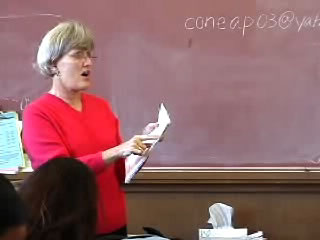
(view Quicktime clip: high
low)
I introduce the day's task to my students. This is the first day that they will be analyzing and responding to an AP English Examination literature prompt. I remind them of the key points they should attend to in their groups, and to rely on their SOAPS strategies to support their investigations. (3:58)
Something I became aware of as I watched this video is how much my classroom reflects my life as a traveler—Tibet, Cambodia, Guatemala—and my politics. I am not being disingenuous here: I am sure that people who see this video or the parts that show my classroom may have some issues with my blatant politicizing my classroom.
Introducing
the class: I almost always start the period by going over all
the things we have to do—to give kids the sense that we don’t
have a minute to waste. That’s big with me—and connects to
what Tim
Boerst said last summer. Teachers have to be purposeful in their lessons;
if we waste time we are disrespecting our students.
On testing: I do give tests on books. I hold them accountable
for assignments. The 90 minutes of writing on a book is my way of preparing
them for college exams but also I allow that much time because I want
them to spend time thinking deeply about the books they’ve read.
Which books? In this case it was non-fiction works they had chosen to
read in small literature circles. That’s why I had to make up individual
tests.
Analyzing text in groups: Influenced by Vygotsky, I see
talk as a tool for learning. So, to prepare kids for writing their “first
official AP text analysis essay” I had them get into groups, read
it, and discuss it as a prelude to writing it on their own two days later.
Here I am influenced by the Goodmans (Ken and Yetta) who also use talk
as a tool for learning but have this neat idea that instead of having
an expert other—the way Vygotsky talks about the Zone of Proximal
Development (ZPD), they believe that kids talking in a small group create
their own sense of expert other; that is, working together, kids in a
group create a real sense of expertise over a piece of text. This was
not the first time I had given these kids a piece of text analysis. We
worked out a few in class. But this was the first AP prompt and passage
they had done.
Diving students into groups and explaining the task:
Before moving kids into groups, I give them clear directions about
what they are going to do in the group. If I do this beforehand, I don’t
have to go around to each group and check that they know what they’re
doing.
How I choose leaders: I change them constantly because
I want all kids to get a chance to lead.
3.
Reading the Prompt & Initial Responses
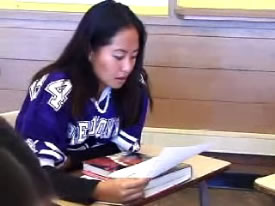
(view Quicktime clip: high
low)
Christine takes the lead—she is a student leader and a good reader. I think it’s important to show this part—how one student reads through it, they attempt a little discussion, and they someone says, “let’s read it again.” (9:09)
4. Establishing
Alternative Interpretations
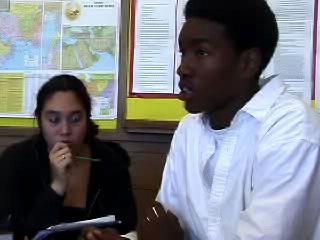
(view Quicktime clip: high
low)
Jerryck sees the passage as a metaphor. “You can take that as two ways”—here for me is a perfect example of reading as a social, cultural act as well as a cognitive act.(2:25)
5. Building on
One Another's Thinking
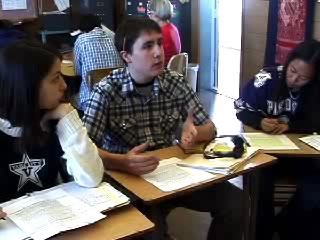
(view Quicktime clip: high
low)
The discussion is so good: they’re taking turns, acknowledging each other, using each others' ideas, defending their ideas, deepening their understanding.(8:00)
Notice Christine always draws the group back to the prompt. “diction”—“Proud club fighter.” The discussion is so good: they’re taking turns, acknowledging each other, using each others' ideas, defending their ideas, deepening their understanding. They ask each other questions and respond. See Petya’s question that Jerryck answers. They listen intently to each other and are doing serious stylistic analysis.
[About this
group: really mixed in terms of major identity in the senior class: Jerryck
is a basketball player (heavily recruited by big schools) and transfer
student—new to EC this year, Ryan is a debater, Christine is senior
class president, Isabel is a techie/Gay Straight Alliance member, Petya
is an immigrant from Bulgaria, Josh is into leadership and drama productions,
Marcelle—shy member of the popular crowd. None of these kids are
close friends outside of class though they are in classes together.]
6.
Scaffolding the Students' Conversation Using SOAPS
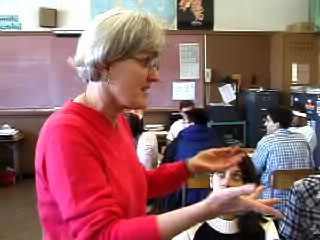
(view Quicktime clip: high
low)
I enter in. Here I couldn’t resist—I’m reacting to Jerryck’s point about Michael Jordan. Then after I have added my 2 cents, I have a teaching moment. I ask them to use the SOAPS technique to push themselves about the SO WHAT of the piece—what else is this about besides the death of Paret? (9:44)